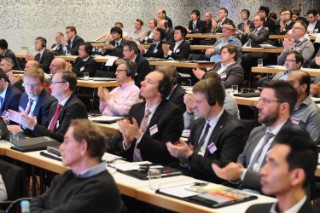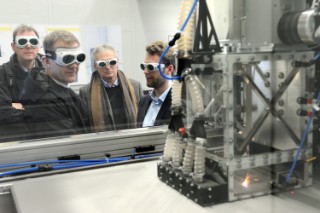ICTM Conference in Aachen
Turbomachinery manufacturing – getting the balance between environmental protection and productivity
A new term was coined recently at the “5th Conference of the ICTM International Center for Turbomachinery Manufacturing Aachen”, which was held on February 6 and 7, 2019. Some 200 participants from 18 countries discussed the best ways to achieve an “ecolonomic” form of turbomachinery manufacturing and deployment – in other words one that reduces both their cost and environmental impact.


Exploring shared interests: since 2011, turbomachinery manufacturers, software developers, tool manufacturers, researchers, machine makers and plant engineering companies have come together at the two-day ICTM Conference in Aachen on a biennial basis to discuss new trends with experts from industries including aviation and power generation. The event is organized by the Fraunhofer Institute for Production Technology IPT and the Fraunhofer Institute for Laser Technology ILT, both of which also participate in the conference as research partners.
Ecolonomic: protecting the environment and saving money
The presentations at the conference covered a wide range of topics including digitalization, production, material selection and the future of turbomachinery manufacturing. The talk here, however, was no longer of a gulf between ecological and economic concerns, but rather the quest to attain “ecolonomic” outcomes, in other words solutions that combine environmental protection and productivity. Currently, there are two major issues affecting the turbomachinery manufacturing sector: on the one hand, the transition to a new energy economy and the stringent requirements this entails and, on the other, the environmental standards set by the International Civil Aviation Organization (ICAO). By 2050, the ICAO will require aircraft to reduce their carbon dioxide and nitrogen emissions by 75 and 90 percent, respectively, and cut their noise emissions by 65 percent. Achieving these goals is complicated by the fact that demand for turbines has been rising for years due to the aviation industry’s buoyant order books.
One speaker, Lars Wagner – Chief Operating Officer of MTU Aero Engines AG in Munich – explained how the company plans to cope with the boom in orders and the corresponding capacity requirements over the next ten years by implementing various solutions, including a smart factory. A further key to boosting productivity will be Additive Manufacturing (AM). MTU is one of the pioneers in the use of this technology in engine construction, with 2000 series-produced AM low-pressure turbine parts currently being used in industry. The production of further AM components with a volume of 25 000 to 30 000 parts per year is planned from 2020.
Additive design improves blade performance
One newcomer to the AM scene is MAN Energy Solutions SE from Oberhausen, which has gained a foothold in the metal 3D printing business with its Laser Power Bed Fusion (LPBF) process. Also known as selective laser melting (SLM), this technique was developed and patented by Fraunhofer ILT. Michael Kleinhenz, Head of Production, explained how LPBF has proved to be a successful technique not just for prototyping, but also for an initial selection of approved parts that are already coming off the assembly line. Kleinhenz’s presentation in Aachen refuted the idea that AM components are inherently more expensive to produce. He noted that the cost of producing a part for a compressor blade cluster has actually fallen, because it no longer consists of 13 separate components, but rather a single component produced by a 3D printer. Other benefits include the ability to employ additive design methods to optimize component design and boost blade performance.
On a tour of Fraunhofer ILT, the conference participants discovered which processes researchers are currently working on to optimize 3D printing for reliable industrial-scale use – a clear indication that AM technology still has plenty more potential to offer. These processes include integrating sensors into the LPBF process, printing 3D components using titanium and high-strength steels and developing material alloys for laser additive manufacturing.
Promising aspects of AM: bigger, faster and more productive
Three ongoing developments attracted particular interest. The first is hybrid additive laser material deposition, an automated additive process that Fraunhofer ILT is currently investigating in a collaborative project (ProLMD) with partners from the aviation industry and other sectors. Funded by the German Federal Ministry of Education and Research (BMBF), ProLMD combines laser material deposition (LMD) with conventional manufacturing techniques. This allows manufacturers to add reinforcements and other geometric elements to cast and forged parts using LMD. Another technique known as extreme high-speed laser material deposition (EHLA) has already been tried and tested in practice and has proved to be a fast and environmentally friendly alternative to hard chrome plating in offshore applications in the Netherlands.
Bulky components measuring 1000 mm x 800 mm x 500 mm can now be manufactured using a scalable LPBF system that surpasses the previous limits of conventional metal 3D printing systems. The ICTM Conference in Aachen also showcased a system with a new laser head that was developed as part of the Fraunhofer focus project futureAM. This boosts productivity by a factor of 10 compared to conventional LPBF systems.